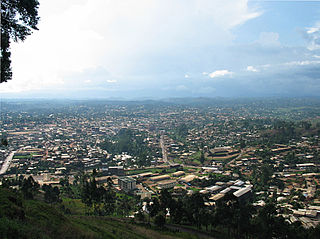
Schutztruppe was the official name of the colonial troops in the African territories of the German colonial empire from the late 19th century to 1918. Similar to other colonial armies, the Schutztruppen consisted of volunteer European commissioned and non-commissioned officers, medical and veterinary officers. Most enlisted ranks were recruited from indigenous communities within the German colonies or from elsewhere in Africa.

Ambazonia, alternatively the Federal Republic of Ambazonia or State of Ambazonia, is a political entity proclaimed by Anglophone separatists who are seeking independence from Cameroon. The separatists claim that Ambazonia should consist of the Northwest Region and Southwest Region of Cameroon. Since 2017, Ambazonian rebels have engaged in armed conflict with the Cameroonian military, in what is known as the Anglophone Crisis, attempted to set up a Government-in-exile and supportive militias have exerted control over some remote regions of the claimed territory. No country has recognized Ambazonia's existence as of 2024.

Bamenda, also known as Abakwa and Mankon Town, is a city in northwestern Cameroon and capital of the Northwest Region. The city has a population of about Six hundred thousand people and is located 366 km (227 mi) north-west of the Cameroonian capital, Yaoundé. Bamenda is known for its cool climate and scenic hilly location.
Articles related to Cameroon include:

Bafut is a town located in a modern commune in Cameroon, it is also a traditional fondom. It is located in the Mezam Department, which in turn is located in the Northwest Province.

Mankon is a geo-historic community constituting a large part of Bamenda in Cameroon, formed as an amalgamation of about five different ethnic groups. The Mankon fondom (kingdom) represents one of the oldest monarchies of the grassfield people of the Northwest Province. The fondom is ruled by a fon (king) with rights to kinghood acquired by birth. The crowned fon is usually a designated son of the deceased king, a child who was born only during his reign.
The Fon of Bafut is the fon or Mfor of the town of Bafut and its adjoining areas in the Northwest Province, Cameroon, which comprise the erstwhile Fondom of Bafut. At present, the Fon of Bafut is still a local ruler, but under the jurisdiction of the Government of Cameroon, and a board of Fons. Bafut is one of the largest villages in the North West Province.

A Fon is a chieftain or king of a region of Cameroon, especially among the Ngie, Widikum, Tikar, and Bamiléké peoples of the Bamenda grass fields and the Lebialem of the South West Region. Following the defeat of Germany in World War I, the Fons of British Cameroon came under British rule, and the Fons of French Cameroon came under French rule. Since Cameroon's independence in 1961, the Fons are under the jurisdiction of the Government of Cameroon. However, they maintain semi-autonomous union councils and jurisdiction over their hereditary land.

Jesko Albert Eugen von Puttkamer was a German diplomat, colonial administrator, and military officer who served as colonial governor of German Kamerun from 1895 to 1907.
The Nso people are from the Bamenda grass fields Northwest Region of Cameroon. Their traditional language is Lamnso and their capital is Kumbo – where the Palace of the Fon is found.

Hans Dominik was a German colonial officer of the Schutztruppe. He was the long-time commander of the Jaunde military station in Kamerun.
The Bafut Subdivision or the Kingdom/Chiefdom/Fondom of Bafut is a commune in the Mezam Department of Northwest Province, Cameroon. It is located in the Western Grassfields region - a name for the Northwest Province and surrounding grassland areas. Bafut is the most powerful of the traditional kingdoms of the Grassfields, now divided into 26 wards along a 10 kilometre stretch of the "Ring Road" that trails along a ridge above the Menchum Valley.

The Adamawa Wars (1899–1907) were initially a series of military expeditions and border conflicts between the German Schutztruppe in Kamerun and the Fula Sunni Muslim states and tribes that were a part of the Sokoto Empire, particularly the Emirate of Adamawa in the northern half of the region. After these territories were annexed major resistance continued for years and several uprisings occurred.

Eugen Ritter von Zimmerer was an attorney, prosecutor and judge in Bavaria before he entered the colonial service in 1887 when he was in his 40s. He served in German colonies of Kamerun and Togo before being appointed as governor of Kamerun, serving between 1890 and 1893. Following that, Zimmerer was assigned to posts in Brazil, Chile and Haiti before retiring and returning to Germany.

The Kamerun campaign took place in the German colony of Kamerun in the African theatre of the First World War when the British, French and Belgians invaded the German colony from August 1914 to March 1916. Most of the campaign took place in Kamerun but skirmishes also broke out in British Nigeria. By the Spring of 1916, following Allied victories, the majority of German troops and the civil administration fled to the neighbouring neutral colony of Spanish Guinea. The campaign ended in a defeat for Germany and the partition of its former colony between France and Britain.

Balikumbat is a village located in Balikumbat Sub Division, Ngoketunjia Division of the North West Region, Cameroon. Balikumbat is the Sub Divisional Headquarter of Balikumbat Sub Division and located about 20.9 km from Ndop town.

Operation Free Bafut was a week-long Cameroonian military operation against the Seven Karta militia in and around Bafut that resulted in the deaths of two separatist generals.
This is a timeline of the Anglophone Crisis in Cameroon during 2022.

Ernst Klaus Iwan Christian Friedrich Alfred von Raben was a German Major who had served as a commander of the Schutztruppe before surrendering at the Siege of Mora.
This is a timeline of the Anglophone Crisis in Cameroon during 2023.












